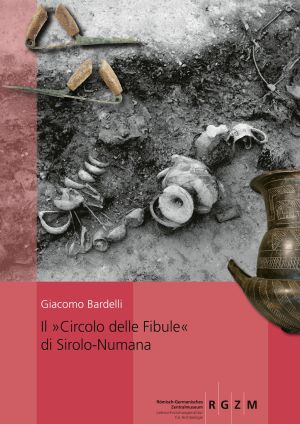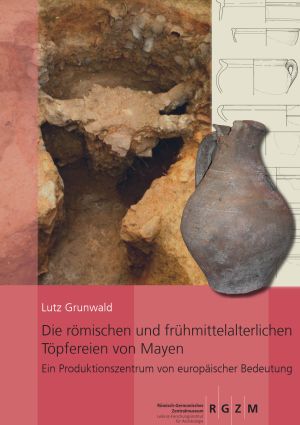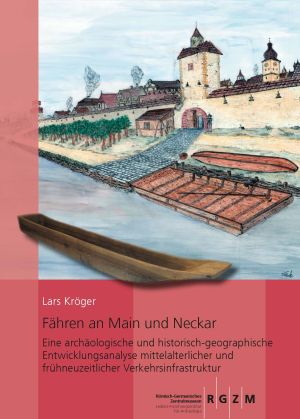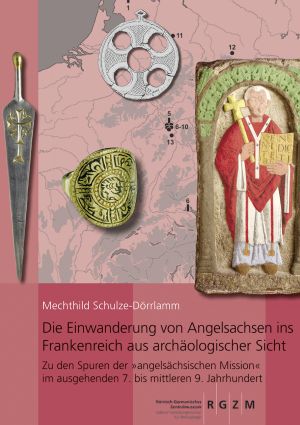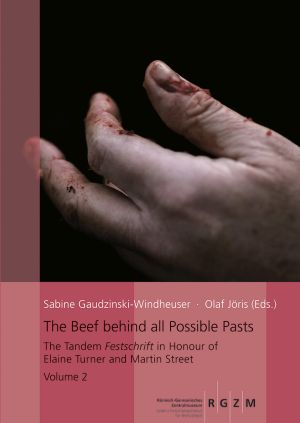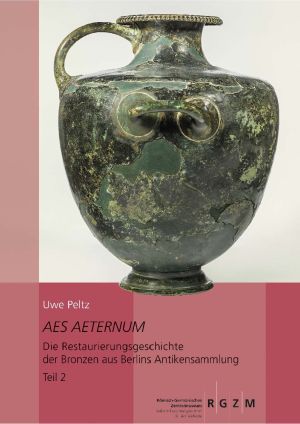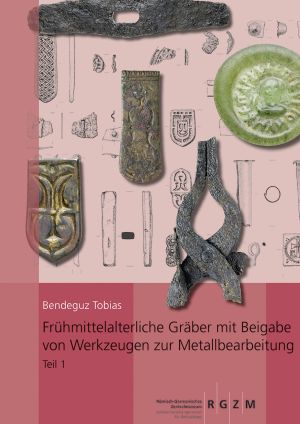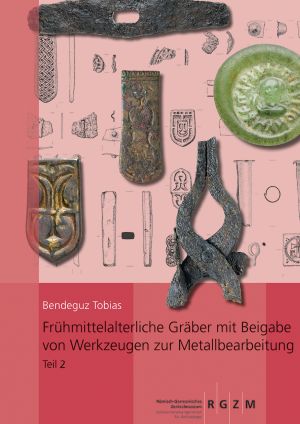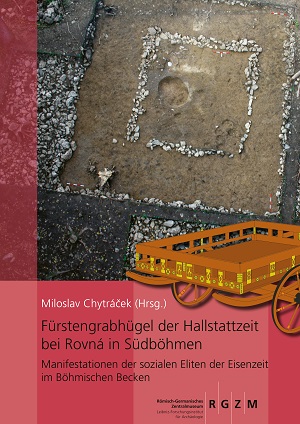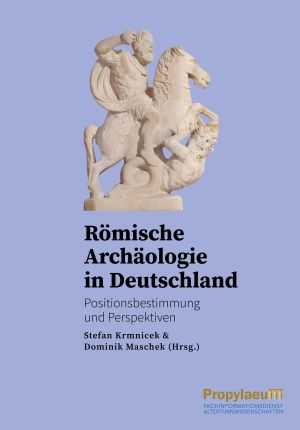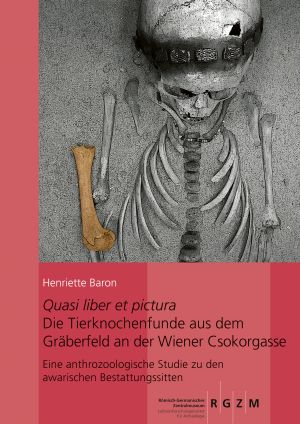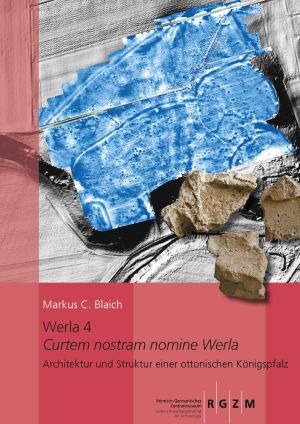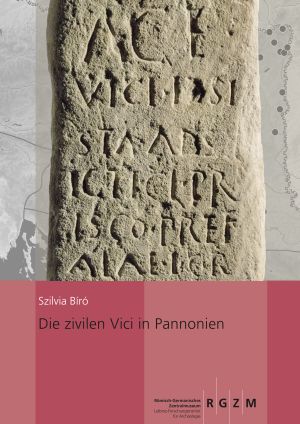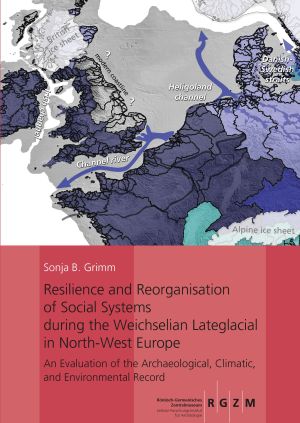Monographien des RGZM
In the Monograph series of the Romano-Germanic Central Museum, Leibniz Research Institute for Archaeology (RGZM), comprehensive studies on prehistoric and early medieval archaeology, history, culture and art are published, based on archaeological, historical and written ancient sources. Additional material and Open Data can be included in the online-version.
The digital content is planned to be enlarged by retrodigitalisation of older volumes.
Additional data on publications of this series
Italian translation of the texts from:
Joachim Weidig, Bazzano – ein Gräberfeld bei L’Aquila (Abruzzen). Die Bestattungen des 8.–5. Jahrhunderts v.Chr., Monographien des RGZM, Band 112 (Mainz 2014)
More publications of the Romano-Germanic Central Museum (RGZM)
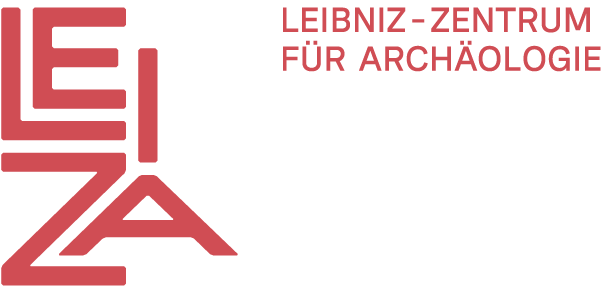
Press
Leibniz-Zentrum für Archäologie
Ludwig-Lindenschmit-Forum 1
D-55116 Mainz
Tel.: +49 6131 8885 0
E-mail: verlag@rgzm.de
Published so far
Il »Circolo delle Fibule« di Sirolo-Numana
Among the most important finds in the pre-Roman Marche, the »Circolo delle Fibule« of Sirolo-Numana (prov. Ancona) stands out for the huge number of fibulae found within its nine tombs – over 1,200 specimens of different types and materials. Discovered in 1970 and never before published, this key context of Picene archaeology is now the subject of a specific study that illustrates the variety of the grave assemblages and the complexity of the local funerary customs. An examination of the grave goods gives an insight into the processes of social structuring taking place in Numana between the end of the 7th century B.C. and the beginning of the 5th century B.C., between a strong conservatism and the first international contacts.
Die römischen und frühmittelalterlichen Töpfereien von Mayen: Ein Produktionszentrum von europäischer Bedeutung
The Mayen ware produced in Mayen is considered characteristic and relevant to dating. These ceramic products were formative for parts of the ancient European economic structure. The Mayen potteries were part of the pre-modern industrial area between the Eastern Eifel and the Rhine. Here, a seamless transfer of knowledge and technology from the Roman era to the early Middle Ages took place throughout the 5th century. The study goes beyond the typochronological assessment of the vessel pottery. It also addresses aspects of the individual lives of the potters in their multi-layered lifeworlds, such as their beliefs, their dependencies on property or the monetary economy.
Fähren an Main und Neckar: Eine archäologische und historisch-geographische Entwicklungsanalyse mittelalterlicher und frühneuzeitlicher Verkehrsinfrastruktur
Rivers such as the Main and Neckar in Germany are the heart of many cultural landscapes. They connect spaces and enable a variety of cultural and economic developments along their banks. At the same time, they form a barrier not easy to cross. Especially at navigable river sections, a reliable infrastructure needs to be provided, that does not disturb or only minimally interferes in the usability of the river. River crossings represent bottleneck situations in road systems. They possess a political and monetary value demanding for regulation and control. For prehistoric periods only fragmented information is accesseable, the medieval and early modern times show a profound complexity of circumstances. The solution to solve this issue is in most cases the use of ferries.
The present study analyses the available archaeological and written sources for the river systems of Main and Neckar in southern Germany. This provides a comprehensive picture of the development of river crossings. The archaeological analysis is based on the exceptional number of 121 logboat finds from the working area. In most cases, they have been parts of complex ferry constructions. This incomparable number allows the definition of local and temporal differences, sets them in contrast with finds from other European regions and gives the opportunity for reliable technical reconstructions.
To solve questions on ownership, legal basis and general use conditions of ferries and bridges published written sources from medieval and modern times on 241 river crossings in the area have been examined and evaluated. They represent a complex system of rights and duties concerning liege lords, ferrymen and ferry passengers. At the same time, it became obvious that fords in typical means did not play a role on navigable rivers other than expected. In this way, this study offers a profound glimpse into regional and supra-regional transportation systems in the heart of Middle Europe.
Understanding Middle Palaeolithic asymmetric stone tool design and use: Functional analysis and controlled experiments to assess Neanderthal technology
In the Late Middle Palaeolithic, the variability of Neanderthals’ lithic technologies in Central and Eastern Europe was complemented by a specific asymmetric tool type – the so called Keilmesser. Due to their morphological characteristics and interpretation as tools in purported long-term use, Keilmesser provide a unique archive for tracing late Neanderthal behavioural features. These may range from understanding tool design, production and dedication, to tool function, use and maintenance; along with aspects of technical innovations and transmission of skills and knowledge.
Three Keilmesser assemblages from the sites of Buhlen, Balver Höhle (both Germany) and La Grotte de Ramioul (Belgium) were analysed. Applying functional analysis combined with controlled experiments in a multidisciplinary approach, published interpretations were tested and evaluated.
The study presented in this book offers a blueprint to a more holistic approach by systematically employing different methods and scales of analysis. This comprehensive view on Keilmesser opens up room for discussions by offering a new perspective on this and, potentially, other specific tool types.
Die Einwanderung von Angelsachsen ins Frankenreich aus archäologischer Sicht.: Zu den Spuren der »angelsächsischen Mission« im ausgehenden 7. bis mittleren 9. Jahrhundert
The 8th century was the peak of an intellectual movement that had led many highly educated men as well as some women from Anglo-Saxons to emigrate to the continent. Their aim was to win the pagan population - especially Frisians and the tribally related Old Saxons - for Christianity or to improve their religious education. Especially in the northern and eastern Frankish Empire, they worked throughout their lives as missionaries, priests, monks and nuns, teachers or instructresses, and sometimes also as scholars. Only a few of the participants in the "Anglo-Saxon mission" are generally known today, e.g. Archbishop Boniface, who was murdered in Friesland, and the missionary Willibrord of Echternach, because until now it has been almost impossible to obtain a comprehensive picture of this group of people.
In this richly illustrated book, 70 men and 15 women who can be proved to have immigrated from Anglo-Saxons are presented for the first time with their names and dates of life. It also contains floor plans of the churches and monasteries they founded, shows the objects from their possessions that still exist today and documents their graves as well as the unique Boniface tomb in Mainz. Five new distribution maps show not only the location of the immigrants' places of activity and burial places, but also the present-day repositories of works of Anglo-Saxon art and crafts as well as the sites of archaeological objects of Anglo-Saxon origin in the Frankish Empire.
The Beef behind all Possible Pasts: The Tandem Festschrift in Honour of Elaine Turner and Martin Street
This Tandem-Festschrift pays tribute to Elaine Turner and Martin Street, to celebrate all you have both contributed to the MONREPOS Archaeological Research Centre and Museum for Human Behavioural Evolution of the Römisch-Germanisches Zentralmuseum, in ensuring high research standards, and for your contributions to Palaeolithic Archaeology in Germany and beyond. It should be understood as a big “CHEERS” from the MONREPOS staff and many other friends and colleagues from all over the world, who contributed to this Festschrift.
The double volume comprises a broad spectrum of topics from the Lower Palaeolithic to the early Holocene and even to the Medieval period – touching upon the vast array of topics Elaine and Martin have dealt with over the last more than 30 years. It starts with the discussion of the oldest evidence for fire and addresses many other key-topics of scientific debate at fascinating levels of detail.
s. Volume 2
The Beef behind all Possible Pasts: The Tandem Festschrift in Honour of Elaine Turner and Martin Street
This Tandem-Festschrift pays tribute to Elaine Turner and Martin Street, to celebrate all you have both contributed to the MONREPOS Archaeological Research Centre and Museum for Human Behavioural Evolution of the Römisch-Germanisches Zentralmuseum, in ensuring high research standards, and for your contributions to Palaeolithic Archaeology in Germany and beyond. It should be understood as a big “CHEERS” from the MONREPOS staff and many other friends and colleagues from all over the world, who contributed to this Festschrift.
The double volume comprises a broad spectrum of topics from the Lower Palaeolithic to the early Holocene and even to the Medieval period – touching upon the vast array of topics Elaine and Martin have dealt with over the last more than 30 years. It starts with the discussion of the oldest evidence for fire and addresses many other key-topics of scientific debate at fascinating levels of detail.
s. Volume 1
AES AETERNUM: Die Restaurierungsgeschichte der Bronzen aus Berlins Antikensammlung
With the rediscovery of ancient cultures, the desire for permanence of their material heritage became established, and thus the restoration of cultural objects. To understand their history provides an access to the technical possibilities and the practical procedures of the early restorers as well as to the aesthetic to archaeological ideas of the art dealers, collectors and custators in museums.
An important field of activities was offered by the ancient bronzes.
The collection of the Berlin Antikensammlung is one of the most important outside the Mediterranean area. This collection writes a history of restoration of almost 500 years, which becomes illustrative in its essential facets with the support of finds from other museums.
Volume 2, see hier.
AES AETERNUM: Die Restaurierungsgeschichte der Bronzen aus Berlins Antikensammlung
With the rediscovery of ancient cultures, the desire for permanence of their material heritage became established, and thus the restoration of cultural objects. To understand their history provides an access to the technical possibilities and the practical procedures of the early restorers as well as to the aesthetic to archaeological ideas of the art dealers, collectors and custators in museums.
An important field of activities was offered by the ancient bronzes.
The collection of the Berlin Antikensammlung is one of the most important outside the Mediterranean area. This collection writes a history of restoration of almost 500 years, which becomes illustrative in its essential facets with the support of finds from other museums.
Volume 1, see here.
Römische Landnutzung im antiken Industrierevier der Osteifel
From the beginning of the Roman Imperial period, the area between Mayen on the edge of the Eifel and Andernach on the Rhine experienced an enormous increase in its economic activity. In a short time, an industrial area developed there, from which wide areas in the Roman north-western provinces were supplied with high-quality basalt lava millstones, light tuff and later also heat-resistant ceramics. Quarries were newly established, land and water routes were expanded, existing outlets were extended and others were still to be developed. Setbacks in the 3rd and 4th centuries were followed by further booms.
How could the numerous workers and their families be fed, and what consequences did the success of the stone and energy-intensive pottery industries have for the environment? In order to clarify this, two Roman villas on the northern edge of the Mayen millstone quarries were investigated with geophysical measurements, excavations, geoarchaeological and botanical studies, and their entire surroundings were explored. The results are presented in this book. The inhabitants of the villa Mendig, »Im Winkel« were themselves involved in the production of millstones. In late antiquity, a surface drainage system there probably kept a transhipment point for millstones on the Segbach dry, while a fortified storage building ensured the supply of the quarrymen. Quarry owners resided in the villa Mendig, »Lungenkärchen«. It turned out to be an axial courtyard with an impressive water basin. Inspections led to the discovery of the burial ground belonging to »Lungenkärchen« with monuments made of Lorraine limestone as well as the discovery of a previously unknown vicus »Im Terl«.
Frühmittelalterliche Gräber mit Beigabe von Werkzeugen zur Metallbearbeitung
The custom of giving metalworking tools to a deceased person in the grave has been known since the Copper Age and is widespread in Europe, Asia and Africa. This volume attempts to trace this practice, taking into account the spiritual culture of the respective epoch. The picture of the archaeological legacy is completed by written and pictorial sources.
The work gives an overview from the Copper Age to the Middle Ages of all the graves in which forging tools were found. A few selected examples from the early Middle Ages are treated in more detail in individual studies.
In addition to the archaeological findings, epigraphic, iconographic, documentary and historical sources provide the basis for a new interpretation.
Volume 2, s. here.
Frühmittelalterliche Gräber mit Beigabe von Werkzeugen zur Metallbearbeitung
The custom of giving metalworking tools to a deceased person in the grave has been known since the Copper Age and is widespread in Europe, Asia and Africa. This volume attempts to trace this practice, taking into account the spiritual culture of the respective epoch. The picture of the archaeological legacy is completed by written and pictorial sources.
The work gives an overview from the Copper Age to the Middle Ages of all the graves in which forging tools were found. A few selected examples from the early Middle Ages are treated in more detail in individual studies.
In addition to the archaeological findings, epigraphic, iconographic, documentary and historical sources provide the basis for a new interpretation.
Volume 1, s. here.
Fürstengrabhügel der Hallstattzeit bei Rovná in Südböhmen: Manifestationen der sozialen Eliten der Eisenzeit im Böhmischen Becken
In 2012-2013, an archaeological rescue excavation was carried out in the cadastral municipality of Rovná near Strakonice in Bohemia in the large Hallstatt period burial complex 1. The reason for the excavation was the illegal robbery in 2009, when five bronze vessels were torn out of the ground. Without context, the objects had only the value of a single find. In order to preserve this newly identified and immediately threatened burial complex with characteristics of a so-called princely tomb, it was necessary to carry out a rescue excavation within the framework of the programme for internal support of international cooperation projects of the Academy of Sciences of the Czech Republic. The project focused on a detailed area excavation of the threatened burial mound with special attention to modern archaeological and bioarchaeological methods. The excavation as well as the research work was carried out in close cooperation between the Archaeological Institute of the Academy of Sciences of the Czech Republic Prague, the South Bohemian Museum in České Budějovice, the South Bohemian University in České Budějovice and the Roman-Germanic Central Museum in Mainz. The discovered features as well as the artefacts are unique in all of Central Europe: Two Hallstatt period elite burials with many extraordinary finds were uncovered, as well as a secondary Latène period burial pit and an early medieval child's grave. The bronze vessels and all other artefacts from Rovná are now owned by the South Bohemian Museum in České Budějovice. This monograph contains the summary of all research results obtained during the investigation of burial mound 1 in Rovná, including the graphic and photographic documentation of the artefacts found as well as the archaeological contexts.
Brandstrukturen im späten Magdalénien: Betrieb, Nutzung und Funktion
The use of fire was one of the decisive milestones in the evolution of humans and their behaviour. Over the course of thousands of years, the element of fire became increasingly important. To this day, it plays a central role in human life - a role that goes far beyond craft and culinary use: fire increasingly became the centre of social life and ultimately forms the basis of our civilisation.
The multi-layered evaluation of Palaeolithic fire structures and their immediate surroundings provides important contributions to the understanding of the spatial and social behaviour of hunter-gatherer groups, not least in the context of the emergence of supra-regional sets of rules, which become archaeologically tangible especially in the late Upper Palaeolithic.
A comparative, diachronic evaluation of fire structures requires a standardised and generally applicable methodological apparatus. With the present work, a starting point was created, based on the partly excellently preserved hearth features from the Late Magdalenian. On this basis, it was possible to develop a comprehensive set of methods and at the same time to test them for their applicability and significance. In this way, a detailed picture of the use and significance of fire after the peak of the last cold period was created.
I tripodi a verghette in Etruria e in Italia centrale: Origini, tipologia e caratteristiche
The Etruscans were excellent bronze craftsmen: this is proven both by numerous archaeological finds and ancient written sources. Especially between the 6th and 5th centuries BC, the Etruscan bronze workshops reached a very high level of craftsmanship and specialised in the production of household goods and banquet accessories, which were exported to all corners of the Mediterranean and north of the Alps.
Among the most valuable creations of the Etruscan bronze craftsmen were the staff trivets, a kind of stand assembled from several cast pieces and decorated with small figurative decorations. As one of the most important and significant elements of banquet accessories, they were often part of lavish funerary furnishings inside and outside Etruria, and because of their symbolic value they were even consecrated in sanctuaries. Their peculiarity emerges above all from the figural representations that adorned them and at the same time marked them as bearers of mythological stories.
A detailed study clarifies the typological connections of these Etruscan works of art with their models from the Near East and Greece by carefully examining all their technological and stylistic aspects. Thus, the significance of the staff triforms and their nature of prestigious objects for the Etruscan and non-Etruscan elites is fully revealed.
Cemeteries and Sedentism in the Later Stone Age of NW Africa: Excavations at Grotte des Pigeons, Taforalt, Morocco
Grotte des Pigeons, Taforalt (Morocco), is one of the most famous cave sites in North Africa. We present new findings on the Iberomaurusian hunter-gatherer inhabitants who faced major challenges of a rapidly changing climate.
In this volume we describe archaeological evidence covering the period 23,000 to 12,500 years ago. We examine the nature of environmental and behavioural changes, culminating in a major broadening of the food spectrum at around 15,000 years ago, linked to technological innovation in some aspects but conservatism in others. The cave also came to be used as a substantial human cemetery, enabling us to explore burial practices and recover additional information on diet and life-styles.
Die Karolingerzeit in Pannonien
This volume takes a detailed look at a period of the Carpathian Basin that has so far not been known at all, or only scarcely known at all: the eastern expansion of the Carolingian Empire - those scarcely 100 years that lie between the fall of the Avar Khaganate and the emergence of the Hungarian principality.
Pannonia, the new eastern province of the Carolingian Empire, comprised most of Transdanubia and the Sava-Drava interfluve, where smaller counties were established from the middle of the 9th century. The best known of these was the county in Lower Pannonia with its centre Mosaburg, which Priwina and his son Chezil developed into Zalavár-Vársziget (Castle Island) from the 840s. In Lower Pannonia, which belonged to the missionary district of the Salzburg archbishopric, up to 30 churches were built between 840 and 870, five of which are already considered archaeologically identified today. Constantine (Cyril) and his brother, Methodius, who was appointed Archbishop of Pannonia, were briefly active in Mosaburg. At the end of the 880s, a royal palace of Arnolf of Carinthia, the East Frankish king, stood here. He left Mosaburg to Duke Braslav in 896, who surrounded the settlement with a strong rampart construction.
Thanks to the excavations that have continued for over 70 years, we now have a reliable picture of the history of the settlement, the architectural and artistic monuments, the social hierarchy, the ethnic composition and the cultural connections of the Mosaburg county.
Der Schatzfund aus dem Stadtweinhaus in Münster / Westfalen und vergleichbare Schatzfunde des hohen und späten Mittelalters als archäologische Quelle
The starting point of the study is the detailed analysis of the treasure find from the Stadtweinhaus in Münster/Westphalia. With an ensemble of richly decorated jewellery, it is not only one of the largest late medieval treasure finds in Central Europe, but also a prime example for the entire source group due to its typical find and research history.
Through the comprehensive evaluation of the treasure find, the traditional interpretation as the hoard of a Jewish pawnbroker is questioned for the first time and expanded by alternative interpretations. The comparison with 324 treasure finds rounds off the study on the source value of these intentionally deposited collections of valuable objects.
Table appendix see here.
Quasi Liber et Pictura: Die Tierknochenfunde aus dem Gräberfeld an der Wiener Csokorgasse – eine anthrozoologische Studie zu den awarischen Bestattungssitten
Animal bones in Avar cemeteries are often interpreted as food offerings for the dead or, more generally, as "sacrifices". But why did the Avars choose certain animals and animal parts to place in the graves of their dead?
Henriette Baron presents the animal bone finds from the Avar cemetery at Csokorgasse in Vienna, analyses burial practices and provides a detailed overview of Avar animal remains from the 7th and 8th centuries - with the aim of gaining new insights into what people actually saw in the animals. It becomes clear that the interpretation as food offerings sometimes falls short; the selected animals and animal parts had deeper meanings. There is also evidence of a change in the practice of offering animals over several generations, which may be linked to fundamental social changes.
On closer inspection, animals are "like a book and a painting" - "quasi liber et pictura" - a mirror of our being, as Alain de Lille wrote in the 12th century.
Die römische Besiedlung im Umland der antiken Tuffbergwerke am Laacher See-Vulkan
On the Rhine, north of the Moselle, Caesar's troops found a fertile basin with farmsteads and a flourishing millstone trade. The Germanic occupation and the urbanisation policy of Emperor Augustus meant, among other things, the beginning of stone building in Germany. In particular, the tuff deposits around the Laacher See volcano became the focus of Roman builders. An ancient industrial landscape had already developed here in early Roman times, and the conditions for its development were particularly favourable - high-quality volcanic rock and the Rhine port of Andernach only 5 km away.
This book deals with more than 200 Roman settlement sites and the development of society in this part of Upper Germania over a period of some 450 years. The introduction of the tuff industry and the stationing of Roman troops quickly gave rise to a prosperous, provincial Roman mixed culture. Even after serious destruction in the 3rd century, a prosperous society developed again in the advanced 4th century until the first half of the 5th century, with increasing immigration of Germanic tribes. Outstanding finds already known, such as the Nickenich niche tomb or the Kruft column, are analysed in their overall context. Archaeological finds from the 1st to the 5th centuries, mainly from graves of the early imperial period and the first half of the 2nd century, are newly presented. More than 20 water pipes, mostly of qanat construction, as well as a presumed civil miners' settlement shed light on the characteristics of rural settlement in the area of the Roman tuff mines.
Byzantinische oder byzantinisierende Raumgestaltungen kirchlicher Architektur im frühárpádenzeitlichen Ungarn: Eine vergleichende Analyse auf Grundlage von Parallelen aus dem Balkan
The question of "Byzantine" churches in the early Árpádic kingdom of Hungary is one of the central problems of archaeology and historiography of Hungary and all the Balkan states that emerged on the territory of the former Árpádic empire. However, a careful review of the churches, taking into account their history of research, shows that only a small part of the churches designated as Byzantine for partly nationalistic reasons actually had models in Byzantium.
Werla 4: Curtem nostram nomine Werla – Architektur und Struktur einer ottonischen Königspfalz
The overall analysis of Werla combines the evaluation of the old excavations from 1934-1939 and 1957-1964 with targeted post-excavations and minimally invasive sondages.
Werla's staggered fortifications are a mark of military strength, and their monumental architecture showcases royal power. The outer castles are dominated by simple pit houses and storage buildings used for craft production, which show Werla to be an economic centre in the sense of elite economy.
The analysis of the small finds offers a different perspective than the architecture. It enables statements to be made about the founding period, the heyday and the abandonment of the palatinate. In addition, mounted, high-ranking visitors to the royal palace and their closer entourage and even the rarely present royal court can be identified.
In the middle 11th century Werla was abandoned, its palatine functions transferred to Goslar. In a supra-regional view, this can be related to the economic and political structural change that the East Saxon region underwent when the kingship passed from the Ottonians to the Salians.
As an outstanding example of Ottonian ruling architecture and with its integration into the wider surrounding countryside and its structuring as a separate imperial district, Werla at the same time stands for the changed role that the Harz region played in the political concept of the 10th and 11th centuries.
Additional information you find here: https://doi.org/10.11588/data/SZSS58
Studien zur spätbronzezeitlichen Chronologie im westlichen Mitteleuropa und in Westeuropa
The studies were carried out as preliminary work for an investigation of the Bronze Age river finds from the northern Upper Rhine. Based on the Late Bronze Age chronology advocated by the author since 1987, on the Hallstatt B chronology of Swiss research (limited to Switzerland and its immediate surroundings) and on dendrochronological data also for Bronze Age D, the possibilities of the stage division, the time approaches of the stage boundaries and the supra-regional validity of these stages and stage boundaries were again explored. It is not a matter of a systematic description of the contents of the stages, but rather of proving in principle that the close-meshed sequence of stages in stages of mostly 60 years, which can be found on the Rhine, Moselle and in Switzerland, can be transferred to the Urnfield Culture over a wide area, and can also serve as a standard for the chronology of the Atlantic Bronze Age.
Die zivilen Vici in Pannonien
The civil vici show different characteristics in building forms and settlement structures in the western provinces than those in the eastern provinces. Pannonia had to be of special importance as a link. Here one finds rather village settlements with strong pre-Roman roots next to the "traditional" small-town settlements.
Based on the results of the numerous recent excavations, this study sheds light on the role of the Zivilvici in the economic life of the province, the characteristics of building and settlement structure or their social composition. With regard to the Romanisation process, the survival of various pre-Roman elements in the vici and the changes in pre-Roman settlement structures were also investigated.
Resilience and Reorganisation of Social Systems during the Weichselian Lateglacial in North-West Europe: An Evaluation of the Archaeological, Climatic, and Environmental Record
At the end of the Pleistocene, hunters and gatherers had to adapt themselves and their social systems in North-West Europe to abrupt climate and significant environmental changes. This adaptation process is reconstructed in detail based on 25 archaeological sites and in connection with high-resolution climate and environmental archives. Based on this rigorous correlation, a chronological relation between climatic, environmental, and cultural change is established that for the first time allows founded statements about cause and effect. This study reveals that the Pleistocene social systems could cope with the significant climate changes but that they were stretched beyond their limits by quickly changing environmental conditions.



